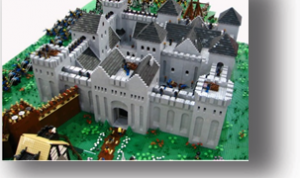10.2.1 Analysis
On a basic level, analysis refers to the conceptual strategy of “part-to-whole.” Because I grew up playing with LEGOs® (or, more often, the cheap knock-offs), I like to use this analogy: Imagine a castle built of 1000 LEGO bricks. I can look at the entire structure and say, “Oh, that’s a castle”—this is a reasonable interpretation. But to understand how that castle has actually come together, I pull a few of the LEGO bricks from various parts of the structure. I look at those bricks individually, closely examining each side (even the sides that I couldn’t see when they were part of the castle).
When I say, “This is a castle,” I am not analyzing. But next, perhaps I ask myself, “What is each of these blocks doing to create what I can clearly interpret as a castle?” This is the process of analysis.


Which bricks to choose, though? As we discussed in Chapter One, attention is always selective: we automate most of our daily experience for the sake of efficiency and survival, so we often overlook the trees when we see the forest—or each LEGO brick when we see the castle.
Analysis, then, is a practice of radical noticing (like description): it invites you to attend to the details that add up to a complex reality. But analysis also involves conscientious focus of your attention, or a perspective. Just like reading glasses can bring these words into focus, an analytical perspective brings specific ideas, words, or patterns into sharper focus, making them easier to process and interpret.
Sometimes, especially in English classrooms, analysis of a text is referred to as critical reading. Importantly, critical reading as a technique is not a magical key to meaning not a super-secret decoder ring for a deeply encrypted code. Rather, it is a means to unpack a text and construct a unique, focused interpretation. Close reading is a repetitive process: by repeatedly encountering, unpacking, and discussing a text, you can develop an analytical insight through guided and focused interpretation of its meaning.
In an analytical situation, your readerly purpose might determine your focus: for example, if you’re trying to convince a friend that Wonder Woman is a feminist film, you would keep your eyes peeled for images, words, and other markers that align with such an interpretation, like situations featuring independent powerful women or an equitable ratio of dialogue spoken by female characters vs. male characters. It is important to note, though, that good analysis embraces curiosity and allows you to notice elements that might contradict, complicate, or nuance your original purpose: in addition to finding evidence in support of your interpretation, you should also be aware of characteristics that push back against your expectations.
